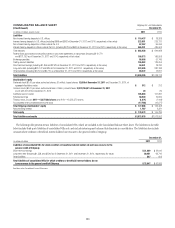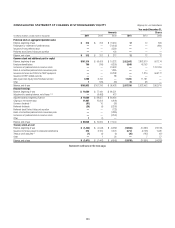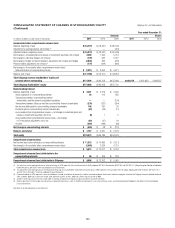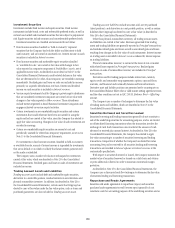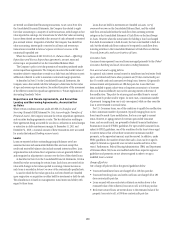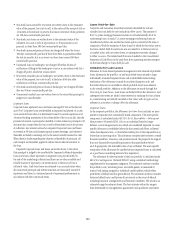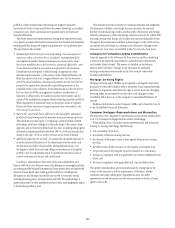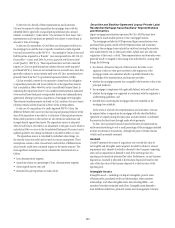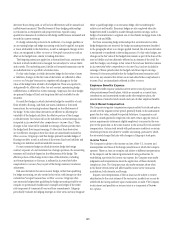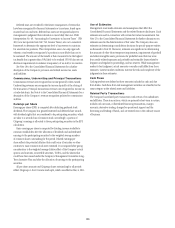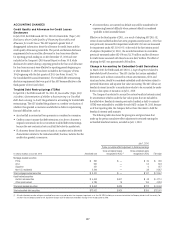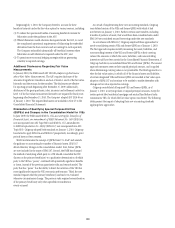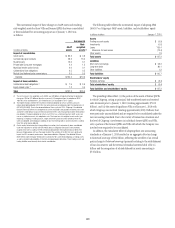Citibank 2011 Annual Report Download - page 161
Download and view the complete annual report
Please find page 161 of the 2011 Citibank annual report below. You can navigate through the pages in the report by either clicking on the pages listed below, or by using the keyword search tool below to find specific information within the annual report.139
are treated as collateralized financing transactions. As set out in Note 26 to
the Consolidated Financial Statements, the Company has elected to apply
fair value accounting to a majority of such transactions, with changes in fair
value reported in earnings. Any transactions for which fair value accounting
has not been elected are recorded at the amount of cash advanced or received
plus accrued interest. Irrespective of whether the Company has elected fair
value accounting, interest paid or received on all repo and reverse repo
transactions is recorded in Interest expense or Interest revenue at the
contractually specified rate.
Where the conditions of ASC 210-20-45-11, Balance Sheet—Offsetting:
Repurchase and Reverse Repurchase Agreements, are met, repos and
reverse repos are presented net on the Consolidated Balance Sheet.
The Company’s policy is to take possession of securities purchased under
reverse repurchase agreements. The Company monitors the market value of
securities subject to repurchase or resale on a daily basis and obtains or posts
additional collateral in order to maintain contractual margin protection.
As described in Note 25 to the Consolidated Financial Statements, the
Company uses a discounted cash flow technique to determine the fair value
of repo and reverse repo transactions. See related discussion of the assessment
of the effective control for repurchase agreements in “Future Application of
Accounting Standards” below.
Repurchase and Resale Agreements, and Securities
Lending and Borrowing Agreements, Accounted for
as Sales
Where certain conditions are met under ASC 860-10, Transfers and
Servicing (formerly FASB Statement No. 166, Accounting for Transfers of
Financial Assets), the Company accounts for certain repurchase agreements
and securities lending agreements as sales. The key distinction resulting in
these agreements being accounted for as sales is a reduction in initial margin
or restriction in daily maintenance margin. At December 31, 2011 and
December 31, 2010, a nominal amount of these transactions were accounted
for as sales that reduced Trading account assets.
Loans
Loans are reported at their outstanding principal balances net of any
unearned income and unamortized deferred fees and costs except that
credit card receivable balances also include accrued interest and fees. Loan
origination fees and certain direct origination costs are generally deferred
and recognized as adjustments to income over the lives of the related loans.
As described in Note 26 to the Consolidated Financial Statements, Citi has
elected fair value accounting for certain loans. Such loans are carried at fair
value with changes in fair value reported in earnings. Interest income on
such loans is recorded in Interest revenue at the contractually specified rate.
Loans for which the fair value option has not been elected are classified
upon origination or acquisition as either held-for-investment or held-for-sale.
This classification is based on management’s initial intent and ability with
regard to those loans.
Loans that are held-for-investment are classified as Loans, net of
unearned income on the Consolidated Balance Sheet, and the related
cash flows are included within the cash flows from investing activities
category in the Consolidated Statement of Cash Flows on the line Change
in loans. However, when the initial intent for holding a loan has changed
from held-for-investment to held-for-sale, the loan is reclassified to held-for-
sale, but the related cash flows continue to be reported in cash flows from
investing activities in the Consolidated Statement of Cash Flows on the line
Proceeds from sales and securitizations of loans.
Consumer loans
Consumer loans represent loans and leases managed primarily by the Global
Consumer Banking and Local Consumer Lending businesses.
Non-accrual and re-aging policies
As a general rule, interest accrual ceases for installment and real estate (both
open- and closed-end) loans when payments are 90 days contractually past
due. For credit cards and unsecured revolving loans, however, Citi generally
accrues interest until payments are 180 days past due. Loans that have
been modified to grant a short-term or long-term concession to a borrower
who is in financial difficulty may not be accruing interest at the time of
the modification. The policy for returning such modified loans to accrual
status varies by product and/or region. In most cases, a minimum number
of payments (ranging from one to six) are required, while in other cases the
loan is never returned to accrual status.
For U.S. Consumer loans, one of the conditions to qualify for modification
is that a minimum number of payments (typically ranging from one to
three) must be made. Upon modification, the loan is re-aged to current
status. However, re-aging practices for certain open-ended Consumer
loans, such as credit cards, are governed by Federal Financial Institutions
Examination Council (FFIEC) guidelines. For open-ended Consumer loans
subject to FFIEC guidelines, one of the conditions for the loan to be re-aged
to current status is that at least three consecutive minimum monthly
payments, or the equivalent amount, must be received. In addition, under
FFIEC guidelines, the number of times that such a loan can be re-aged is
subject to limitations (generally once in twelve months and twice in five
years). Furthermore, Federal Housing Administration (FHA) and Department
of Veterans Affairs (VA) loans are modified under those respective agencies’
guidelines and payments are not always required in order to re-age a
modified loan to current.
Charge-off policies
Citi’s charge-off policies follow the general guidelines below:
Unsecured installment loans are charged off at 120 days past due.
Unsecured revolving loans and credit card loans are charged off at 180
days contractually past due.
Loans secured with non-real estate collateral are written down to the
estimated value of the collateral, less costs to sell, at 120 days past due.
Real estate-secured loans are written down to the estimated value of the
property, less costs to sell, at 180 days contractually past due.






